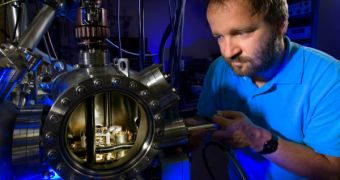Measuring the electric charge on single atoms is not something that hasn't been done before, but now researchers from IBM's Zürich research laboratory have improved on their previous work, and shown that atomic force microscopes (AFM) can successfully replace scanning tunneling microscopes (STM) in doing the job.
Using an STM yields good results as well, and it was an IBM researcher who, back in 2004, first proved that measuring the electric charge on single atoms with this technology was possible. But, according to the experts, an AFM is more suited for the job, because it does not require that the analysis sample be set on a conductive layer.
A scanning tunneling microscope has a quite simple construction principle. It boasts a tip only a few atoms wide (in some cases just one atom wide), which is used to analyze microscopic samples. It is brought down on the sample, and it then passes an electrical current through it. The conductive surface underneath helps drive the current through the material that needs studying. The microscope then analyzes the variations that the electrical current experiences while running through the sample, and determines some of its properties.
With AFM, IBM researchers believe they may have found a more elegant solution. This type of microscope also has a tip just one atom wide, but it's kept in place by a cantilever, a beam just a few nanometers across. This diving board has a small voltage running through it, but the current does not pass through the sample and underneath. The cantilever vibrates because of this voltage close to its natural frequency. This ensemble is then brought down very close to the sample, which is usually made up of either a single atom, or just a few.
When brought this close to each other, the atom at the tip of the AFM and the atom in the sample interact on the basis of the “opposite charges attract” principle, which means that the interactions between the two atoms will slightly change the way the cantilever resonates and oscillates. Despite the fact that these variations are less than one atom's size in one direction or the other, researchers are able to analyze them and determine if gold or silver atoms have an extra electron, or if they lack one.
“That is what makes this technique so important; it's not only the charge state of an atom but we want to go further and investigate molecules and measure distribution of charges. We're not directly aiming at making a photovoltaic cell or a computer in our system. We're trying to understand the basics of the processes in such devices,” Dr. Leo Gross, from IBM, told the BBC News.

 14 DAY TRIAL //
14 DAY TRIAL //